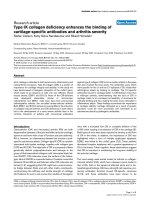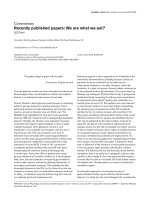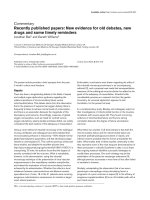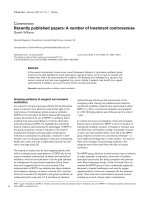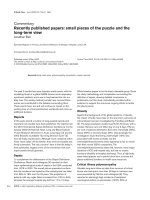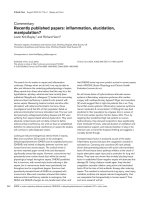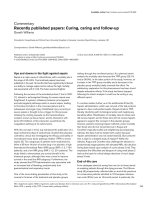Báo cáo y học: "Recently published papers: Pandemic flu, the latest ARDS trials, raising legs and other stories" docx
Bạn đang xem bản rút gọn của tài liệu. Xem và tải ngay bản đầy đủ của tài liệu tại đây (41.88 KB, 3 trang )
Page 1 of 3
(page number not for citation purposes)
Available online />Abstract
In this commentary, recent papers covering pandemic influenza,
acute respiratory distress syndrome and cardiovascular issues are
discussed.
Pandemic influenza: preparedness and novel
therapy
The burning question about pandemic flu is when, not if, it will
strike. Given this general consensus and the proven benefits
of planning for such emergencies, it was timely to read the
results of an independent evaluation of preparedness in
Europe [1]. As one might expect, the news is a classical
mixture of good and bad with perhaps the most worrying
deficit being an almost systematic absence of cooperation
and communication between neighbouring states. This is
exemplified by the fact that only three countries have
undertaken simulation exercises, the results of which have yet
to reach the public domain. We can only hope that the clear
messages emerging from this study are acted upon by
governments worldwide.
At the opposite end of the spectrum, an illuminating treatment
hypothesis for some of the severest human cases of H5N1
avian influenza A has been proposed by a collaborative team
from Sweden and Hong Kong [2]. Patients contracting this
infection may develop haemophagocytic lymphohistiocytosis,
which in turn causes multi-organ failure and death. These
authors put forward a convincing argument to consider
treating such patients with a combination of dexamethasone
and the cytotoxic etoposide. They suggest, given the
epidemiology of this disease, that the WHO should consider
undertaking a clinical trial of this therapeutic approach. For a
more detailed review of haemophagocytic lymphohistiocytosis
see [3].
Acute respiratory distress syndrome (ARDS):
ventilatory strategy, moderate dose
corticosteroids and
ββ
-agonists
The difficulties of conducting randomised control trials in the
intensive care unit (ICU) and more especially in ARDS patients
cannot be underestimated. With this in mind, three recent
trials merit consideration.
The Spanish group of ARDS investigators, ARIES, have
published their randomised control trial comparing higher
positive end-expiratory pressure (PEEP)/lower tidal volume
(V
t
) ventilation with lower PEEP/higher V
t
[4]. Their inclusion
criteria were selected to include only patients who fulfilled
standard ARDS criteria after 24 hours of undefined optimal
mechanical ventilation, selecting a group of patients with the
severest disease and an established high mortality. Their
method of PEEP selection in the higher PEEP group was
based on a single measurement of the lower inflection point
of the inflation limb of the pressure volume curve, initial PEEP
being set at 2 cmH
2
O above this level. PEEP was titrated
dynamically on the basis of maintaining a level of oxygenation
in both strategy groups. The trial was stopped early because
of the detection of a dramatic mortality benefit in the higher
PEEP/lower V
t
group. There was also a statistically significant
increase in ventilator-free days and a reduction in the number
of organ failures after randomisation, almost exclusively
cardiac. The authors’ discussion is clear and concise and fully
acknowledges the defects in study design. From a real-world
perspective, they sensibly suggest that a decremental PEEP
trial is perhaps the best current method of establishing this
crucial parameter. In summary, this eloquent study adds
further weight to the case for a higher PEEP (titrated to the
individual patient)/lower V
t
ventilatory strategy in patients with
severe ARDS. The accompanying editorial adds further
valuable insights [5].
Commentary
Recently published papers: Pandemic flu, the latest ARDS trials,
raising legs and other stories
Jonathan Ball
General Intensive Care Unit, St George's Hospital, London SW17 0QT, UK
Corresponding author: Jonathan Ball,
Published: 25 May 2006 Critical Care 2006, 10:143 (doi:10.1186/cc4943)
This article is online at />© 2006 BioMed Central Ltd
ARDS = acute respiratory distress syndrome; ICU = intensive care unit; i.v. = intravenous; PEEP = positive end-expiratory pressure; PLR = passive
leg raising; SV = stroke volume; V
t
= tidal volume.
Page 2 of 3
(page number not for citation purposes)
Critical Care Vol 10 No 3 Ball
In contrast, the ARDSnet trial investigating the safety and
efficacy of moderate-dose corticosteroids in persistent ARDS
[6] fails, in my opinion, to answer either question reliably
despite the considerable efforts of the group. This important
question rose to prominence after the small randomised
control trial published by Meduri and colleagues [7]. The
ARDSnet investigators were handicapped by numerous
problems and managed to recruit only 180 patients from an
eligible pool of 3,464 over a 6-year period. The protocol
specified enrolment at any time point between days 7 and 28
of mechanical ventilation but a post hoc division into those
entered between days 7 and 13 and those entered between
days 14 and 28 was performed. The results demonstrated
statistically significant improvements in the treatment group in
lung mechanics (in the 14 days after enrolment), number of
ventilator-free days, number of organ failures and number of
ICU-free days (all at day 28). However, this failed to translate
into a mortality benefit at 60 or 180 days. The subgroup
analysis seemed to show an excess mortality in the treatment
group, whose enrolment took place on day 14 or later. There
were differences in the incidences of a variety of secondary
endpoints between the two groups, thus rendering the safety
issue equally difficult to address. In short, almost any
interpretation can be placed on the results of this trial, and I
therefore sadly reached the conclusion that it cannot inform
clinical practice.
The third trial of interest is a phase II randomised control trial, of
continuous intravenous (i.v.) salbutamol in ARDS [8]. The
rationale is that β-agonists increase the rate of alveolar fluid
clearance and therefore might accelerate disease resolution.
The authors chose extravascular lung water measurements as
their primary endpoint, with a standard list of secondary
endpoints including 28-day mortality. It is noteworthy that the
dose of i.v. salbutamol used was 15 µg/kg per hour, which
equates to the top end of the recommended dosage range of 3
to 20 µg/min. The treatment group had statistically significantly
lower lung water from day 3 to day 7, with a mean decrease of
27%. Of perhaps greater significance was the finding that
plateau airway pressures were significantly lower in the
treatment group at day 7. There were no significant differences
in any of the other secondary outcomes although, notably, the
mortality rates in both groups were high (58% and 66%,
respectively) reflecting the severity of illness in the study
population. Surprisingly, and in contrast to recent reviews of i.v.
salbutamol in acute severe asthma [9], no safety or tolerability
issues were identified. The conclusion that a phase III trial is
merited on this evidence seems justified. Before this, however,
several issues arise including inhaled versus i.v. administration,
the use of long-acting or short-acting β-agonists, and the
adjunctive use of inhaled and/or systemic corticosteroids.
Corticosteroids and weaning from
mechanical ventilation
Continuing with the corticosteroid and respiratory theme,
although not in ARDS patients, a Taiwanese study has
investigated the association between adrenal insufficiency
and weaning from mechanical ventilation [10]. They screened
all patients ventilated for more than 72 hours and enrolled 93
of the 472 patients identified. The authors found a high
incidence of adrenal insufficiency (70 of 90; 78%). Those
identified were randomised to receive either stress dose
exogenous replacement (50 mg i.v. hydrocortisone, every
6 hours) or placebo (saline). The patients with normal adrenal
function and those given exogenous replacement were
comparable in their durations of mechanical ventilation and
lengths of stay both in the ICU and in hospital. Those in the
placebo group took on average 3 days longer to wean, which
was reflected in their longer ICU and hospital stays. This
study is arguably most notable for providing the impetus to
monitor adrenal function in all critically ill patients, who require
complex organ support for more than few days. Stress dose
replacement should also be continued until the patient has
been weaned from all circulatory and respiratory support.
Cardiovascular issues
A further report from the Sepsis Occurrence in Acutely Ill
Patients (SOAP) group reports a worse outcome in patients
with shock associated with the use of dopamine and
adrenaline (epinephrine) but not dobutamine or noradrenaline
(norepinephrine) [11]. The statistical analysis identified only
dopamine as an independent risk factor for 30-day mortality,
conferring a 20% increase in risk. As with mechanical
ventilation, despite administering vasoactive drugs to support
the circulation of shocked patients for several decades, we
still have insufficient clinical data to support an optimal
therapeutic strategy. This study adds to the concerns of many
practitioners about the use of dopamine, and perhaps it will
create further impetus for well-designed outcome trials of
differing cocktails of drugs.
The issue of the optimal method of assessing the adequacy of
cardiac preload or, perhaps more precisely, volume responsive-
ness remains a daily challenge. Monnet and colleagues have
published a study assessing the utility of the simple bedside
manoeuvre of passive leg raising (PLR) [12]. They performed
this manoeuvre before a dynamic fluid challenge and used
oesophageal Doppler measurements of descending aortic flow
as their estimate of stroke volume (SV). They found that a
minimum of 10% increase in SV with PLR predicted a 15% or
more increase in SV after an infusion of 500 ml of saline over
10 minutes. The calculated sensitivity was 97% and specificity
94%. The obvious attraction of this technique is its simplicity
and ease of repeatability. It will be interesting to see whether it
becomes a widely adopted practice.
Advances in practice lead, perhaps inevitably, to unforeseen
complications. Radiofrequency ablation around the
pulmonary vein is rapidly becoming the treatment modality of
choice for patients with both paroxysmal and chronic atrial
fibrillation [13]. A brief report by Cummings and colleagues
describes nine cases of fatal atrial–oesophageal fistulae
Page 3 of 3
(page number not for citation purposes)
presenting 10 to 16 days after catheter ablation [14]. The
authors stress the wide-ranging presentation of these cases
and the fact that ante-mortem diagnosis was achieved only in
the minority. Three patients did undergo attempted surgical
repair. The authors rightly counsel that this diagnosis be
considered in any patient presenting with fever, malaise,
leukocytosis, dysphagia, upper gastrointestinal haemorrhage
or neurological symptoms after catheter ablation.
Conclusion
Recent studies suggest:
• Checking on your local level of preparedness for
pandemic flu and talking to your neighbours about it.
• Refining your ARDS ventilatory strategy towards ARIES
while taking a pragmatic decision regarding moderate
dose corticosteroids in persistent disease.
• Considering hypoadrenalism in all ICU patients requiring
more than 72 hours of organ support, especially those
who fail to wean from mechanical ventilation.
• And avoiding dopamine and starting PLR?
Competing interests
The author declares that they have no competing interests.
References
1. Mounier-Jack S, Coker RJ: How prepared is Europe for pan-
demic influenza? Analysis of national plans. Lancet 2006, 367:
1405-1411.
2. Henter JI, Chow CB, Leung CW, Lau YL: Cytotoxic therapy for
severe avian influenza A (H5N1) infection. Lancet 2006, 367:
870-873.
3. Emmenegger U, Schaer DJ, Larroche C, Neftel KA:
Haemophagocytic syndromes in adults: current concepts and
challenges ahead. Swiss Med Wkly 2005, 135:299-314.
4. Villar J, Kacmarek RM, Perez-Mendez L, Aguirre-Jaime A: A high
positive end-expiratory pressure, low tidal volume ventilatory
strategy improves outcome in persistent acute respiratory
distress syndrome: a randomized, controlled trial. Crit Care
Med 2006, 34:1311-1318.
5. Marini JJ: Lessons learned: the conditional importance of high
positive end-expiratory pressure in acute respiratory distress
syndrome. Crit Care Med 2006, 34:1540-1542.
6. Steinberg KP, Hudson LD, Goodman RB, Hough CL, Lanken PN,
Hyzy R, Thompson BT, Ancukiewicz M: Efficacy and safety of
corticosteroids for persistent acute respiratory distress syn-
drome. N Engl J Med 2006, 354:1671-1684.
7. Meduri GU, Headley AS, Golden E, Carson SJ, Umberger RA,
Kelso T, Tolley EA: Effect of prolonged methylprednisolone
therapy in unresolving acute respiratory distress syndrome: a
randomized controlled trial. JAMA 1998, 280:159-165.
8. Perkins GD, McAuley DF, Thickett DR, Gao F: The beta-agonist
lung injury trial (BALTI): a randomized placebo-controlled clin-
ical trial. Am J Respir Crit Care Med 2006, 173:281-287.
9. Tobin A: Intravenous salbutamol: too much of a good thing?
Crit Care Resusc 2005, 7:119-127.
10. Huang CJ, Lin HC: Association between adrenal insufficiency
and ventilator weaning. Am J Respir Crit Care Med 2006, 173:
276-280.
11. Sakr Y, Reinhart K, Vincent JL, Sprung CL, Moreno R, Ranieri VM,
De Backer D, Payen D: Does dopamine administration in shock
influence outcome? Results of the Sepsis Occurrence in Acutely
Ill Patients (SOAP) Study. Crit Care Med 2006, 34:589-597.
12. Monnet X, Rienzo M, Osman D, Anguel N, Richard C, Pinsky MR,
Teboul JL: Passive leg raising predicts fluid responsiveness in
the critically ill. Crit Care Med 2006, 34:1402-1407.
13. Wood MA, Ellenbogen KA: Catheter ablation of chronic atrial
fibrillation – the gap between promise and practice. N Engl J
Med 2006, 354:967-969.
14. Cummings JE, Schweikert RA, Saliba WI, Burkhardt JD, Kilikaslan
F, Saad E, Natale A: Brief communication: atrial–esophageal
fistulas after radiofrequency ablation. Ann Intern Med 2006,
144:572-574.
Available online />
